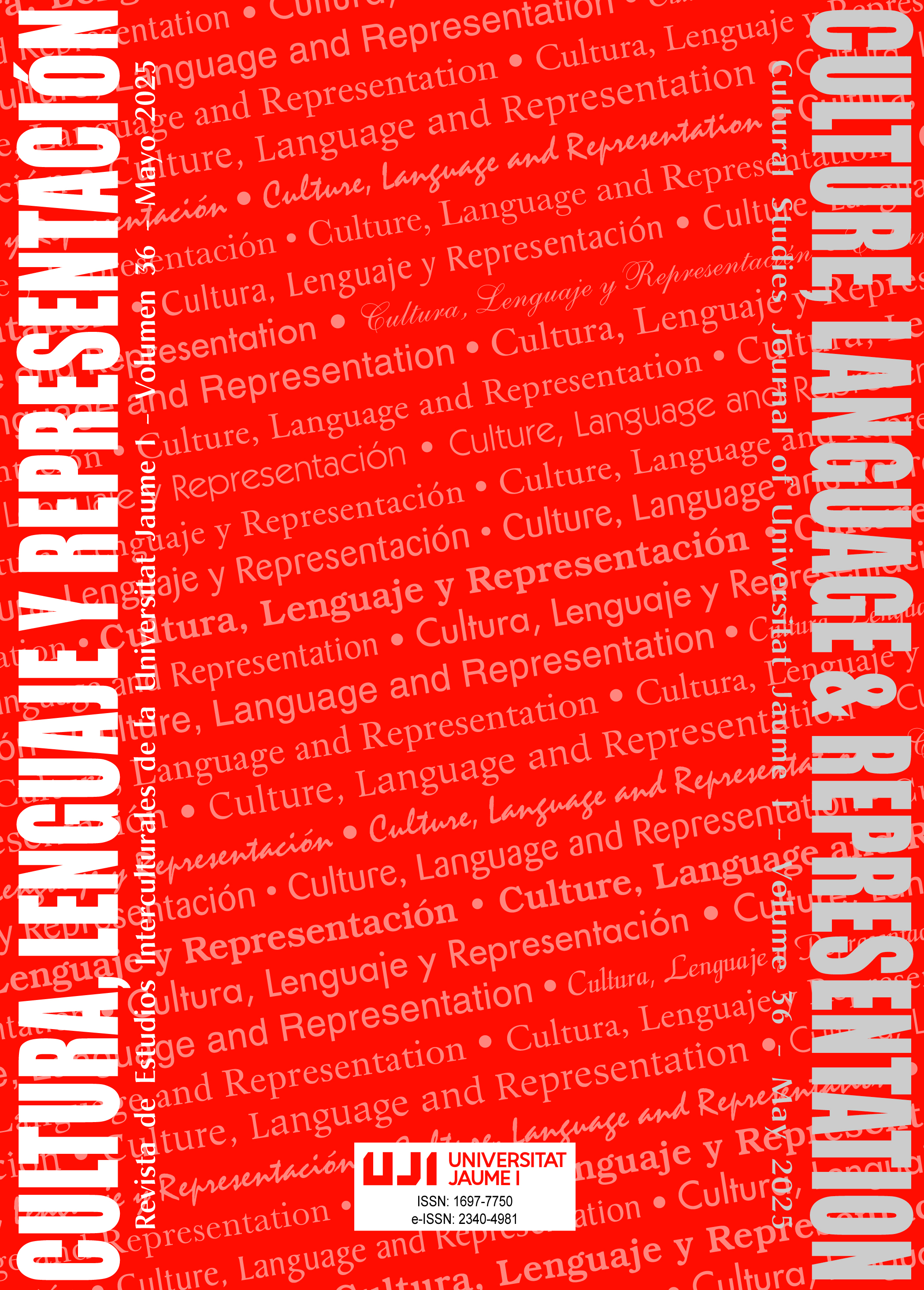Variation parameters in verbal parodic echoing partiality, inaccuracy, and complexity
Main Article Content
Abstract
This article contrasts ironic and parodic echoes. An echo conveys speaker’s dissociation from its source material. In irony, echoes convey content-based criticism, whereas parodic echoes are used to achieve form-based comic effects. Echoic mention is not necessarily an exact repetition. Echoes can vary from their sources along three dimensions: partiality, inaccuracy, and complexity. In irony, partiality has a focal function, which can be complemented with modification and complexity strategies, whereas full echoes are used when no special focal attention is needed or when modification and complexity strategies are enough to highlight particularly significant elements of the utterance. Parody is generally based on partial echoes since it chooses the aspects of the source behavior where imitation can create comic effect with inaccuracy and complexity being used for emphasis. Irony and parody share three complexity strategies: compounding, cumulation, and chaining. Compounding results from combining two relatable echoes into a single communicative act and cumulation from sequencing meaning or form alternates. Finally, in an echoic chain an echo becomes the source material of a second echo that is used to cancel out the meaning implications of the first.
Downloads
Article Details

This work is licensed under a Creative Commons Attribution-ShareAlike 4.0 International License.
An open-access CREATIVE COMMONS copyright license is used. Those authors whose works are published by this journal, accept the following terms:
- Authors will retain their copyright and guarantee the Journal the right to first publish their work, which will simultaneously be subject to the Creative Commons Recognition License CC BY SA that allows third parties to share the work, provided that its author and first publication is indicated.
- Authors may adopt other non-exclusive license agreements for the distribution of the published version of the work (e.g., deposit it in an institutional telematics file or publish it in a monographic volume) provided that the initial publication in this journal is indicated.
- Authors are allowed and recommended to disseminate their work over the Internet (e.g. in institutional telematics files or on their website) before and during the submission process, which can produce interesting exchanges and increase quotes of the published work.
References
Al-Sarhed, Sharefa (2017). A look into mock epic poetry: The rape of the lock by Alexander Pope. International journal of social science and humanities research, 5(2), 43–54.
Attardo, Salvatore (2000). Irony markers and functions: Towards a goal-oriented theory of irony and its processing. Rask. International Journal of Language and Communication, 12(1), 3–20.
Bakhtin, Mikhail (1981). The dialogic imagination. University of Texas Press.
Barnden, John (2020). Uniting irony, hyperbole and metaphor in an affect-centred, pretence-based framework. In A. Athanasiadou & H. L. Colston (Eds), The diversity of irony (pp. 15–65). De Gruyter Mouton.
Beidler, Gretchen (1992). Huck Finn as tourist: Mark Twain's parody travelogue. Studies in American Fiction, 20(2), 155–167.
Booth, Wayne (1974). Rhetoric of irony. University of Chicago Press.
Boxman-Shabtai, Lillian (2018). Reframing the popular: A new approach to parody. Poetics, 67, 1–12.
Clark, Herbert & Gerrig, Richard (1984). On the pretense theory of irony. Journal of Experimental Psychology, 1, 121–126.
Cuddon, John Anthony (1998). Dictionary of literary terms & literary theory. Penguin Books.
Dentith, Simon (2000). Parody. Routledge.
Dupriez. Bernard (1991). A dictionary of literary devices. Harvester Wheatsheaf.
Fishelov, David (2002). Parody, satire, and sympathy in Don Quixote and Gulliver’s Travels. Connotations, 12(2-3), 126–138.
Galera, Alicia (2020). The role of echoing in meaning construction and interpretation. A cognitive-linguistic perspective. Review of Cognitive Linguistics, 18(1), 19–41.
Herischian, Nazila (2012). Jean Rhys’s Wide Sargasso Sea as a Hypertext of Charlotte Bronte’s Jane Eyre: A Postmodern Perspective. International Journal of Applied Linguistics & English Literature, 1(6), 72–82.
Hutcheon, Linda (2000). A theory of parody. The teachings of twentieth-century art forms. University of Illinois Press.
Lozano, Inés (2023). A multidimensional approach to echoing. Categories, uses, and types. Review of Cognitive Linguistics, 21(1), 210–228.
Lund, Roger (1988). Parody in Gulliver’s Travels. In E. J. Rielly (Ed), Approaches to teaching Swift’s Gulliver’s Travels (pp. 81–88). Modern Language Association.
Nafi, Jamal & Daghamin, Rashed (2019). Twain’s handling of humor and satire in his novel the adventures of Huckleberry Finn. European journal of English language and literature studies, 7(4), 33–47.
Peña, Sandra., & Ruiz de Mendoza, Francisco (2017). Construing and constructing hyperbole. In A. Athanasiadou (Ed), Studies in figurative thought and language (pp. 41–73). John Benjamins.
Quine, William Van Orman (1979). Mathematical logic. Harvard University Press.
Pollard, Arthur (1973). Satire. Methuen.
Rossen-Knill, Deborah & Henry, Richard (1997). The pragmatics of verbal parody. Journal of Pragmatics, 27, 719–752.
Ruiz de Mendoza, Francisco (2014). Mapping concepts. Understanding figurative thought from a cognitive-linguistic perspective. Spanish Journal of Applied Linguistics, 27(1), 187–207.
Ruiz de Mendoza, Francisco (2017). Cognitive modeling and irony. In A. Athanasiadou, & H. Colston (Eds), Irony in language use and communication (pp. 179–200). John Benjamins. https://benjamins.com/catalog/ftl.1
Ruiz de Mendoza, Francisco & Barreras, María Asunción (2022). Linguistic and metalinguistic resemblance. In A. Bagasheva, B. Hristov & N. Tincheva (Eds), Figurativity in life and science (pp. 15–41). John Benjamins.
Ruiz de Mendoza, Francisco & Lozano, Inés (2019). A Cognitive-Linguistic approach to complexity in irony: Dissecting the ironic echo. Metaphor and Symbol, 34(2), 127–138.
Ruiz de Mendoza, Francisco & Lozano, Inés (2021). On verbal and situational irony: Towards a unified approach. In A. Soares da Silva (Ed), Figurative language: Intersubjectivity and usage (pp. 213-240). John Benjamins.
Santamaría, Marco Antonio (2015). The parody of the Katabasis-motif in Aristophanes’ Frogs. Les Études classiques 83, 117–136.
Sperber, Dan & Wilson, Deirdre (1981). Irony and the use-mention distinction. In P. Cole (Ed), Radical pragmatics (pp. 295–318). Academic Press.
Wilson, Deirdre (2006). The pragmatics of verbal irony: Echo or pretence? Lingua, 116, 1722–1743.
Wilson, Deirdre (2013). Irony comprehension: A developmental perspective. Journal of Pragmatics, 59, 40–56.
Wittkowsky, George (1943). Swift's Modest Proposal: The Biography of an early Georgian pamphlet. Journal of the History of Ideas, 4(1), 75–104.


